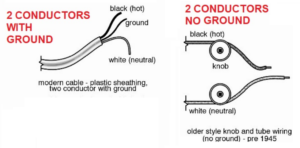Knob & Tube Wiring
Knob and tube wiring is a type of electrical wiring that was commonly used in homes built before the 1940s. While it may still exist in older homes, it is no longer a standard for modern homes. This is due to its many drawbacks, including safety hazards and limitations on modern electrical needs. In this article, we’ll explore the dangers and drawbacks of knob and tube wiring and why it is important to have it replaced.
What is Knob and Tube Wiring?
Knob and tube wiring comes with “neutral,” and “hot” conductors hung from cavities in the walls or ceiling. The conductors are made of copper protected by the insulation of asphalt-filled cloth or natural rubber. The wiring setup used to have porcelain knobs for holding the wires down and keeping them away from combustible wood framing. Also, the wooden framing members were drilled so that these porcelain tubes could be inserted and provide a channel for the conductors going through them.
Safety Hazards of Knob and Tube Wiring
Knob and tube wiring poses several safety hazards that make it a dangerous electrical system to have in your home. First, because the system is not grounded, it increases the risk of electrical shocks and fires. The lack of a grounding wire means that if a short circuit occurs or if there is an electrical fault in the system, there is no safe path for electrical current to flow. Without grounding, the risk of electrical shocks and fires increases significantly.
The insulation used on knob and tube wiring is typically made of cloth or rubber, which can become brittle and crack over time. This can expose the wires and increase the risk of electrical shock or fire. In addition, the insulation used on knob and tube wiring may not be able to withstand the heat generated by modern high-powered appliances. As a result, the insulation may degrade more quickly, making the wiring even more dangerous.
Insulation is also a problem in houses with knob and tube wiring as this kind of setup releases heat into the air. When insulation is placed on top of the wiring this heat can become trapped. Thus, there will be a heat build-up along the wires of the knob and tube wiring system, and the excessive heat can further lead to fire hazards.
Inadequate Capacity
The system was originally designed to handle a limited amount of electrical current such as low voltage electricity for lighting fixtures and small appliances such as radios and fans. As a result, they are inadequate for modern electrical needs. High-powered appliances such as air conditioners, refrigerators, and washing machines draw more electricity than knob and tube wiring systems can safely handle. Retrofitting knob and tube wiring for such applications can cause the wiring to overheat and potentially start a fire.
Furthermore, knob and tube wiring is not compatible with modern electrical systems, such as grounded outlets and circuit breakers. Most modern appliances demand 3-prong outlets which are grounded. However, knob and tube wiring comes with 2 prong systems. Yes, you can use adapters to adjust three-prong outlets with 2-prong system of the knob and tube wiring, but this runs the risk of overloading and short circuit and damaging the appliance.
This configuration can make it difficult to upgrade the electrical system in an older home. It can also make it challenging to meet building code requirements, which can result in fines or other penalties. In addition, some homeowners may find that their electrical needs exceed the capacity of their knob and tube wiring, which can lead to power outages and other issues.
RELATED ARTICLE:MISWIRED ELECTRICAL OUTLETS

Home Insurance Issues
Many insurance companies are reluctant to insure homes with knob and tube wiring because of the safety risks. This can make it difficult to get affordable home insurance. Some policies may be more expensive than the actual cost to have the knob and tube wiring removed. Other insurance companies may require homeowners to have the wiring replaced before they will provide coverage, which can be costly. Homeowners should check with their insurance company to determine if their policy covers knob and tube wiring and what the requirements are for coverage.
Things to Keep in Mind If You Have Knob & Tube Wiring at Home
Homeowners abide by certain things if knob and tube wiring is present in their property. The things to follow are:
- Confirmation of safe installation and modification of the system by an electrician
- Use of fewer appliances in the home to reduce electrical requirements
- Replacement of brittle or cracked wiring
- Grounded wiring
- Your bathroom, kitchen, laundry room, or outdoors must not have knob and tube wiring
- Removal of insulation in the surrounding area of the knob and tube setup
- Rewiring a house if the knob and tube wiring is deemed unsafe by the electrical contractor
Along with these, a homeowner should also consider whether rewiring is absolutely needed or not. If you are about to buy a house with knob and tube wiring, you should get a proper estimation of the charges for replacing the existing setup. You can then negotiate with the purchase price and seal the deal at a lower price.
Upgrading to Modern Electrical Systems
Replacing knob and tube wiring can be expensive. It often involves rewiring the entire house, which can be time-consuming and costly. The cost of replacing knob and tube wiring can vary depending on the size of the house, the extent of the wiring, and the type of electrical system that is installed. However, homeowners should consider the cost of replacing knob and tube wiring as an investment in their safety and the value of their home.
Knob and tube wiring can also be difficult to evaluate because the wires are often hidden behind walls and ceilings. This can make it difficult to identify potential safety hazards. In some cases, the wiring may have been modified or improperly installed, which can increase the risk of electrical problems. Homeowners should hire a licensed electrician to inspect their knob and tube wiring and recommend a course of action.
Nevertheless, the safest and most cost-effective solution for homes with knob and tube wiring is to upgrade to a modern electrical system. This involves rewiring the entire house and replacing outdated systems with modern ones. While the cost of upgrading can be significant, homeowners should consider it as an investment in their safety and the value of their home. Upgrading to a modern electrical system can also increase the home’s energy efficiency and reduce utility costs over time.




